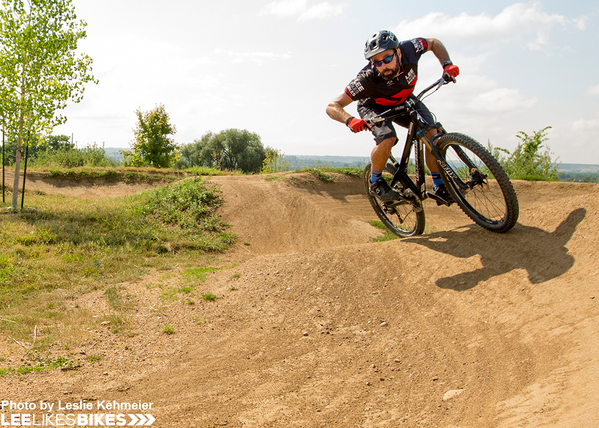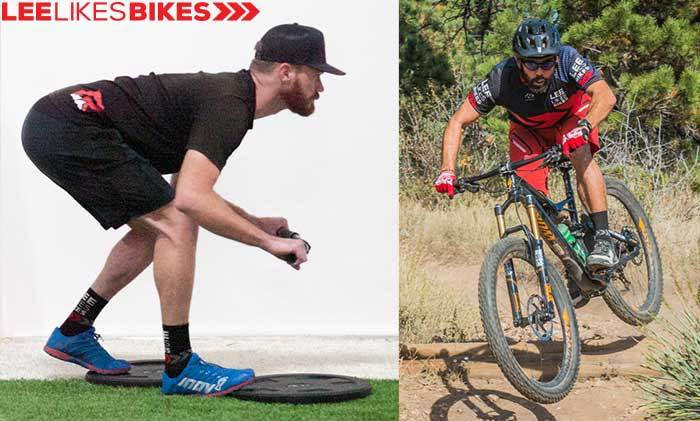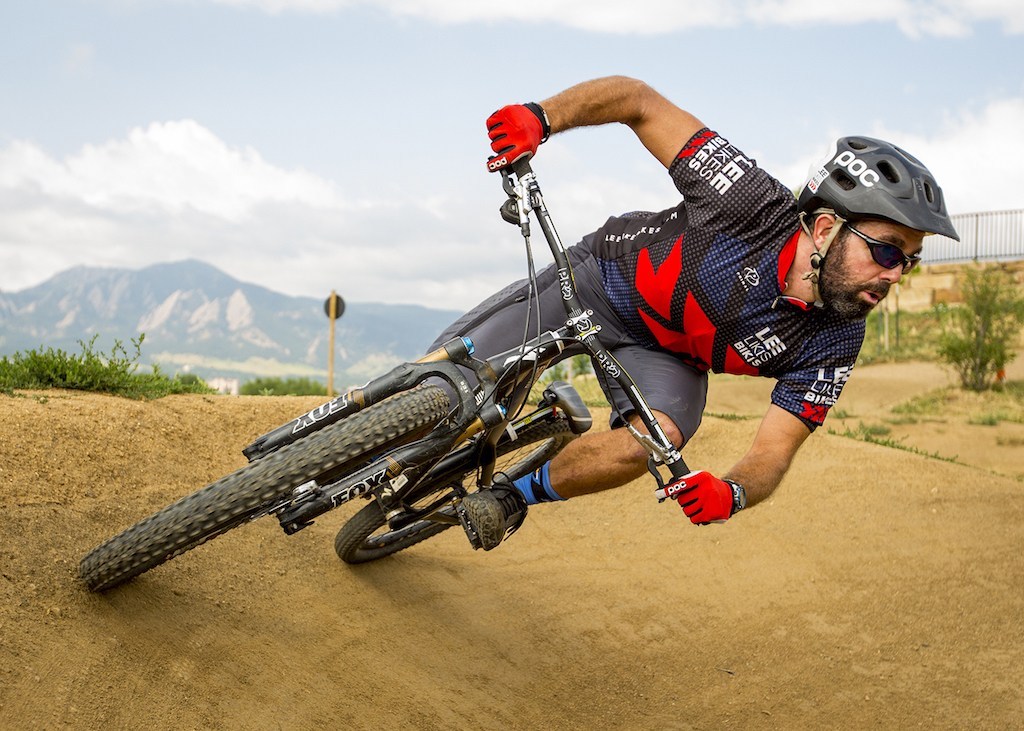For new riders, corners can be intimidating and scary. For expert riders, corners are so much fun! (And they're still sometimes scary.)
Like learning a musical instrument or mastering kung fu, learning to corner is a life-long pursuit. Here are some basic tips to get you started:
1. Get low. Lower.
 First of all, we need to position you for cornering success. As you approach every corner, focus on these six keys to correct body position:
First of all, we need to position you for cornering success. As you approach every corner, focus on these six keys to correct body position:
Hinge at your hips. Push your hips back and fold your torso level (see the above photo). This position supports your weight with your hamstrings and glutes rather than your quads. Try this on your next long downhill, and I'll bet your quads burn less.
Bring your shoulders down very low. The closer they are to your handlebars, the more range of motion you have for cornering. If you're human, when you're nervous you push your head away from danger, which means you raise your shoulders and lose control of your bike. Get low... Lower than that.
Relax your elbows behind your hands. Traditional wisdom (which I once helped spread) was that your elbows should be pointing out like some crazy DH chicken. That's wrong, and I'm sorry for misleading so many people. Most of the time, for optimal control, your elbows should be directly behind your hands.
Hold the bars with tea party fingers. Tension is the enemy of flow, which makes it the enemy of fun. Balance all of your weight on your feet. Keep your hands weightless. If you feel pressure on your palms, you're too far forward. If you feel pulling on your fingers, you're too far back. The less tension you have in your hands, the better your bike handles, and they less you get beaten up.
Ride with heavy feet, light hands. This is redundant with the last point, but that is on purpose. In order to corner well, you must put all of your weight in your feet and keep your hands weightless. This centers you between your wheels, where you're safe, and it lets your bike handle as awesomely as it was designed.
Drop your outside foot. When you aggressively pump a corner (e.g., in a perfect and supportive berm) keep your feet level. When you're trying to survive a sketchy turn (e.g., on off-camber gravel), put all of your weight on your outside pedal. While riding with your outside foot-down isn't always the fastest way to turn, it's a safe way, and you should practice this technique until it's instinct. 
A good, low hip hinge is the key to shred. | Rider: Lee. Model: Dr. Dane DeLozier from Revo Physiotherapy and Sports Performance.
2. Lean your bike. More.
In order to make your bike change direction safely and reliably and shreddably, two conditions must be met. Wait, let's make that three:
1. You must balance on your feet with low shoulders.
2. You must lean your bike independently of your body. Do not let your body lean with the bike.
3. You must be stoked.
Numbers one and three are important! We covered number one in the last section, so here we'll focus on number two.
To see the essence of how a bike wants to turn, watch this video. You can simply lean your bike over (with weightless hands) and let the bike's geometry do the work.
When you lean the bike under you, independently of your body, it keeps your weight balanced over your feet and lets you adjust the lean angle of your bike without disrupting your balance. The tighter the turn, the more you have to lean the bike, and the lower you need to be. When you're nervous, you're going to push your head up, and you won't be able to turn, and you'll get even more nervous. So, get low and lean your bike!
Here's a video that shows how to properly lean your bike:
3. Look ahead. Farther.
Your brain likes to send your body to wherever you're looking. If you've ridden a bike on densely wooded trails, you know what happens when you stare at a tree — you hit that tree.
There's an interplay between your technical skills (getting low, balancing on feet, leaning the bike) and your vision. When you look ahead on the trail you see the big picture. It frees your lizard brain to execute your skills at the best of your ability.
If you're not comfortable, your lizard brain won't let you look ahead. This is why you often end up staring at the trail right in front of your front wheel. Your lizard brain isn't OK with what's going on, and it's telling you to slow down.
 Here's some good vision hygiene to practice:
Here's some good vision hygiene to practice:
Soft focus. When you focus intently on a specific object (rock! rock! rock!) that's hard focus. When you don't focus on anything in particular, and you take in the whole scene, that's soft focus. Most of the time, you want soft focus. Don't look at anything — but see everything.
Peek ahead. When you exit a turn, peek ahead to the beginning of the next turn. When you reach that point, peek to the end of that turn. This gives your brain good data to send you where you want to go. I believe that when you reach a point you've already looked at, your lizard brain will be like, "I remember this spot!" and be cool.
Scan. As you start cornering, scan as far ahead as you can. If your lizard brain tells you to look at something, look at it quickly, then get back to scanning. The more skilled and experienced you become, the more you'll scan and the less you'll stare.
I hope you find this helpful!
—Lee
Lee McCormack is a world-renowned mountain bike skills author and instructor who's worked with thousands of riders of all styles and levels. You can learn way more from his books, online school, and classes. Check them out at www.leelikesbikes.com.

